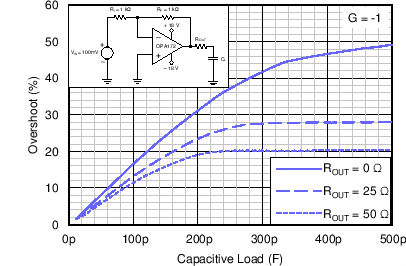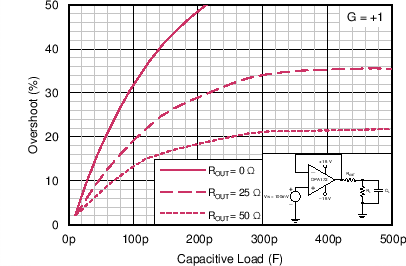JAJSFG2I December 2013 – May 2018 OPA172 , OPA2172 , OPA4172
PRODUCTION DATA.
- 1 特長
- 2 アプリケーション
- 3 概要
- 4 改訂履歴
- 5 概要(続き)
- 6 Device Comparison
- 7 Pin Configuration and Functions
- 8 Specifications
- 9 Detailed Description
- 10Applications and Implementation
- 11Power-Supply Recommendations
- 12Layout
- 13デバイスおよびドキュメントのサポート
- 14メカニカル、パッケージ、および注文情報
パッケージ・オプション
メカニカル・データ(パッケージ|ピン)
サーマルパッド・メカニカル・データ
- D|8
発注情報
9.3.3 Capacitive Load and Stability
The dynamic characteristics of the OPAx172 are optimized for commonly-used operating conditions. The combination of low closed-loop gain and high capacitive loads decreases the phase margin of the amplifier and may lead to gain peaking or oscillations. As a result, heavier capacitive loads must be isolated from the output. The simplest way to achieve this isolation is to add a small resistor (for example, ROUT = 50 Ω) in series with the output. Figure 44 and Figure 45 show graphs of small-signal overshoot versus capacitive load for several values of ROUT. Refer to Application Bulletin SBOA015 (AB-028), Feedback Plots Define Op Amp AC Performance, available for download from www.ti.com, for details of analysis techniques and application circuits.
 Figure 44. Small-Signal Overshoot vs Capacitive Load (100-mV Output Step)
Figure 44. Small-Signal Overshoot vs Capacitive Load (100-mV Output Step)  Figure 45. Small-Signal Overshoot vs Capacitive Load (100-mV Output Step)
Figure 45. Small-Signal Overshoot vs Capacitive Load (100-mV Output Step)